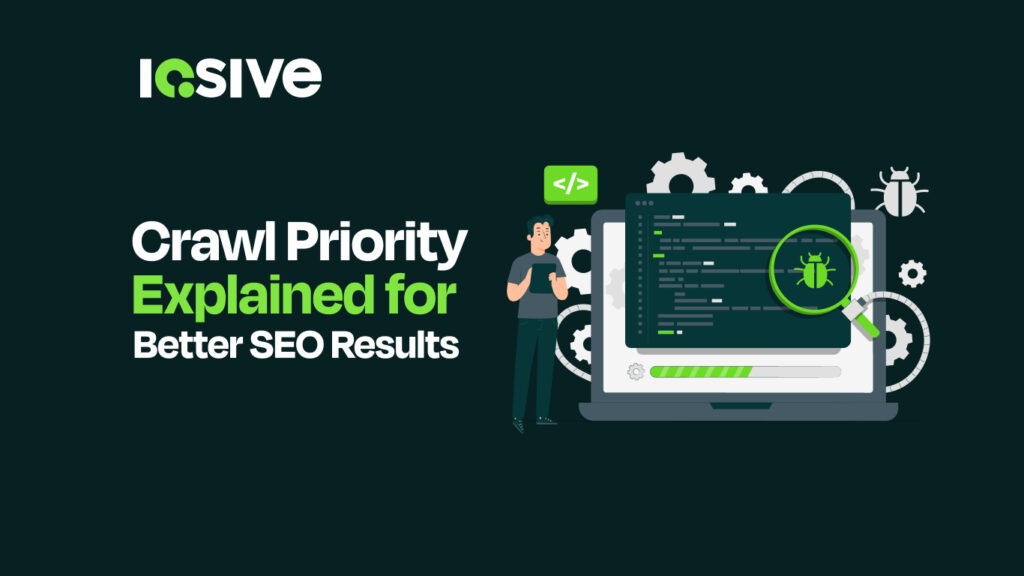Crawl priority determines which pages on your website search engines visit first and how often they return. When managed well, it ensures that your most important content gets discovered and indexed quickly. In this blog, we’ll break down what crawl priority is, how it works, and how you can optimize your site to influence it effectively.
What is Crawl Priority?
Crawl priority is the level of importance that search engines assign to each page on a website when deciding which pages to crawl first. Since search engines have limited time and resources to spend on crawling each site, they rely on signals to determine which pages deserve attention sooner. Pages that are more valuable, more frequently updated, or better connected within the site are usually given higher crawl priority.
This concept helps search engines manage their crawl budget efficiently. Factors like internal links, external backlinks, sitemap entries, page freshness, and overall page authority all contribute to a page’s crawl priority.
How Google Assigns Crawl Priority
Google determines crawl priority by analyzing several factors that help it decide which URLs are most worth crawling first. Since it cannot crawl every page of every website constantly, it uses a system to assign importance to pages based on how useful, accessible, and frequently updated they are. This process is not just based on best practices but is backed by multiple patents that give insight into how Google’s crawling systems are designed.
1. Page Importance and Link Signals
One of the strongest indicators of crawl priority is the perceived importance of a page. Pages with many internal links or backlinks from authoritative sites are often considered more valuable. Google’s original PageRank algorithm plays a key role here, passing authority through links and influencing how crawl resources are distributed.
2. URL Evaluation and Priority Scoring
According to Google’s patent US8676783B1, a system is used to assign a priority score to each URL before crawling. This score considers the likelihood that the content has changed, the historical usefulness of the page, and its value in relation to others. URLs with low scores may be skipped entirely, while high-priority URLs are crawled earlier and more frequently.
3. Sitemap Data and Scheduling
Google also uses sitemap data submitted by webmasters to help schedule crawls. The US8417686B2 patent explains how Google uses sitemap information like <priority> and <changefreq> to evaluate when and what to crawl. While Google does not treat these tags as absolute instructions, they serve as helpful hints.
4. Content Freshness
Pages that are updated often, such as news sites or blogs, may be crawled more frequently. Google’s crawlers use change detection and past behavior to adjust their visit schedules, giving more priority to pages that are regularly refreshed with useful content.
5. Server Response and Crawl Efficiency
Fast-loading websites are easier for Googlebot to crawl. If a server is slow or frequently returns errors, Google may reduce the crawl rate or deprioritize crawling until stability improves. This ensures efficient use of resources and avoids overloading the site.
6. Duplicate Content and Canonicals
When a website contains duplicate content or poor canonical tag usage, it wastes crawl resources. Google tends to lower the priority of URLs that offer little original value or are flagged as duplicates by canonical tags or redirects.
Google’s crawling system is dynamic. It continuously adjusts based on how pages perform, how often they change, and how useful they are for search results. By understanding the factors behind crawl priority and referencing how Google patents describe these systems, webmasters can improve their site structure and content strategy to ensure important pages get crawled and indexed efficiently.
Common Crawl Priority Issues
Here are the most common crawl priority issues:
1. Orphan Pages
Orphan pages are pages that exist on your site but aren’t linked from anywhere else internally. Since search engines rely on links to discover content, these pages are often missed or crawled late, even if they hold value.
2. Overuse of Faceted Navigation and Filters
E-commerce sites and large blogs often generate thousands of near-duplicate URLs through filter or sort options. These variations can overload your crawl budget and dilute focus from more valuable pages.
3. Duplicate Content
Duplicate pages reduce crawl efficiency. When multiple URLs serve the same or very similar content, search engines may spend time crawling pages that offer no new value.
4. Poor Site Structure
A flat or unorganized structure makes it hard for search engines to determine which pages matter most. Without a clear hierarchy, Google may crawl your site inefficiently.
5. Broken Links and Redirect Chains
Internal links that lead to 404 pages or multiple redirects slow down crawling and reduce the crawl priority of affected URLs.
6. Noindex Tags or Robots.txt Misuse
Incorrectly using noindex or disallowing important folders in your robots.txt file can block search engines from accessing pages you want to rank.
How to Influence Crawl Priority on Your Website
Improving crawl priority means helping search engines understand which of your pages are most important. While you can’t directly control how often Googlebot crawls your site, you can influence it by making structural, technical, and content-based improvements that signal value and relevance.
Here are key ways to increase crawl priority for important pages:
1. Strengthen Internal Linking
Link important pages from your homepage or other high-authority pages on your site. Google uses internal links to discover and evaluate page importance. The more accessible and connected a page is, the higher its priority becomes.
Tip: Use descriptive anchor text and link relevant content logically.
2. Keep High-Value Pages Updated
Fresh content signals to Google that a page is active and worth revisiting. Update key pages like service pages, blog posts, or product listings regularly to encourage more frequent crawling.
3. Submit and Maintain an XML Sitemap
Your sitemap acts as a roadmap for search engines. Ensure it includes only valuable, index-worthy URLs. Remove outdated or low-value pages to focus crawl efforts where they matter most.
Note: While <priority> tags in sitemaps are not always strictly followed, they provide helpful hints.
4. Optimize Site Speed and Server Performance
A slow-loading site discourages crawling. Make sure your hosting is reliable and your site is optimized for speed. Use tools like Google PageSpeed Insights to identify and fix performance issues.
5. Fix Crawl Errors
Use Google Search Console to monitor crawl errors and resolve issues such as broken links, server errors, or redirect loops. Clean crawl paths make it easier for bots to access your important content.
6. Avoid Duplicate and Thin Content
Pages with duplicate or very little content are often deprioritized. Use canonical tags properly and consolidate similar content to reduce index bloat and focus Google’s attention on unique, valuable pages.
7. Use Robots.txt and Noindex Tags Strategically
Block non-essential or low-value pages from being crawled using robots.txt or the noindex directive. This helps preserve crawl budget for pages that actually contribute to your SEO goals.
How to Add a Specific URL to the Crawl Priority Queue
If you have published or updated an important page and want Google to crawl it as soon as possible, there are a few reliable ways to increase its visibility and push it into Google’s crawl queue. While you cannot force immediate crawling, these methods can help prioritize the URL for faster discovery and indexing.
Use URL Inspection Tool in Google Search Console
The most direct method is through the URL Inspection Tool in Google Search Console.
- Go to Google Search Console
- Paste the specific URL into the search bar at the top
- Click “Request Indexing”
This signals to Google that the page has been added or updated and should be re-evaluated. It does not guarantee immediate crawling, but it often speeds up the process.
Final Thoughts
Crawl priority plays a key role in how efficiently search engines discover, evaluate, and index your content. While you can’t fully control how Google assigns crawl frequency, you can influence it by following best practices. Addressing crawl priority issues ensures your most valuable content isn’t buried or overlooked. By helping search engines crawl smarter, not harder, you improve your site’s chances of better visibility and rankings in search results.









